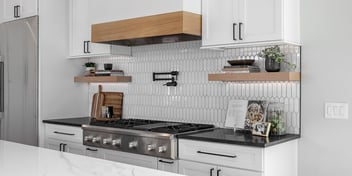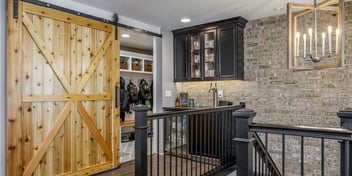7 Min Read
Essential Guide to Stylish and Durable Kitchen Floor Tile
Beautiful and functional kitchens can be built from the ground up, and what flooring homeowners choose for their spaces makes a difference. From what they're made of to how they look, there's much to consider when deciding on kitchen floor tile. Here are some questions to get you started as you think about your project.
What Are the Most Common Materials For Kitchen Tile?
Knowing some basics about kitchen tiles makes the design process smoother and conversations with designers more effective.
Ceramic and Porcelain
These two kinds of tiles are made using the same process of shaping clay that is fired in a kiln. But how are they different and which should you choose?
Ceramic Tile
This tile is made with a coarser mix of clay than porcelain and is fired at a lower temperature. They are less dense than porcelain, so they are easier to cut and install but also less durable. A broad range of colors and designs are glazed onto the top layer making it easy to match styles of all kinds. While they are cost-effective, they are more porous and require regular maintenance to protect them from absorbing water.
Porcelain Tile
Porcelain uses a higher-grade clay and is fired at a much higher temperature. This creates a harder tile that is waterproof, resists stains, and stands up in high-traffic areas. However, their density makes them more brittle while being cut during installation. Unlike ceramic, porcelain tile typically has color running through the tile, which adds to its longevity. Due to the cost of manufacture and difficulty of installation, the price is higher than ceramic tile.
Natural Stone
Slate, limestone, marble, and granite are all types of stone tiles and are an elegant option for texture and color in your kitchen. Their organic look is a sophisticated way to bring the outside inside. If you are interested in the look of stone but would prefer ceramic tile, you can get one that mimics stone. However, the realistic appearance doesn't always hold up under close inspection.
This kitchen flooring is strong and relatively easy to clean. However, it may need resealing periodically to keep it protected. Stone retains heat and is well-matched with an underfloor heating system, but it can be chilly without it.

Engineered Tiles
Terrazzo
Terrazzo is a tile made from chips of marble, granite, quartz, and glass bound in cement or epoxy. The fabrication process creates random patterns and shapes with no two tiles being the same. Terrazzo floor tiles were not often seen in kitchens in the past, but this has been changing thanks to its reputation for holding up in high-traffic areas and how easily it integrates into a variety of aesthetics.
Depending on what material is included inside the terrazzo, the cost can vary quite a bit. While it is being used more now, it may not be to everyone's taste if you are concerned about resale.
.jpg?width=960&height=1279&name=allison-saeng-xSDAlu2zcLg-unsplash%20(1).jpg)
Encaustic Cement
In encaustic cement tiles, the pattern is infused into the tile as part of manufacturing. Mineral pigments are inlaid by hand into cement held in a mold, which is then put under high pressure in a hydraulic press. The tiles have some variation and will not have a uniform look. Encaustic cement tile makes for a very durable and distinctive kitchen floor. Due to the handmade nature of these tiles, they can be expensive.

Are There Other Considerations to Keep in Mind?
Grout
Grout is the material that sits between tiles. There are both practical concerns and aesthetic ones when deciding what to use with your flooring.
When it comes to material, most of the options have a cement base, and what sets them apart is what is added to it. The three most common are unsanded, sanded, and high-performance polymer. Another option is an epoxy base. All of these are very durable and good for high-traffic areas like a kitchen. However, the cement-based grouts must be sealed every few years to keep them properly maintained.
Unsanded
This cement grout has a smooth texture and is good for areas with higher humidity as it is resistant to moisture and mold. It should only be used with seams that are 1/8" or less. With anything larger, it is prone to cracking and crumbling.
Sanded
Sanded grout is cement that includes a small amount of sand, which adds to its durability. It must have seams larger than 1/8" as it can damage tiles with anything smaller. It can attract dirt and is highly absorbent, so it must be sealed regularly.
High-Performance Polymer
This grout has latex polymers blended into the cement for added strength in areas with very heavy use. It comes in both sanded and unsanded versions, and the same benefits and drawbacks exist as those without the polymers. The biggest downside is the higher cost.
Epoxy
Epoxy resin is the base for this grout. It is the most durable, and as it's non-porous, it is stain-resistant and requires minimal maintenance. However, there is a higher degree of difficulty for installation, and it is more expensive than other options.
For the look of your kitchen flooring, you have the choice of matching the grout to your tile or using a contrasting color. If you have a smaller kitchen space or don't want to draw as much attention to your floors, use one that blends in with your tile. If you've chosen to have a pattern or shapes, a grout that is much lighter or darker than your tile will make it stand out.
Texture and Slip-Resistance
Kitchen safety extends down to your floor, and the tile you choose is part of the equation. A textured surface, like that often seen in wood-look tiles, is much safer than a polished, high-gloss one. Some tile even comes with a rating indicating its slip resistance, which can be useful for deciding what to put in wetter environments.
Underfloor Heating
As I've mentioned, kitchen tile can be cold underfoot. The best way to handle this is with underfloor heat. There are two kinds of heating systems. The most common is done with electric mats that sit in the mortar under the tile. The other is a hydronic system which uses pipes with hot water for radiant heat. These are placed under the wood subfloor and are best installed in houses with basement access.

Where to Start with Design?
The easiest way to narrow down the possibilities for the design of your kitchen flooring is with the basics: pattern, color, and size. I suggest that if you want to play with these but aren't ready to commit to your entire kitchen, start with a small space, like a pantry.
Pattern
Patterns in kitchen floors may exist within the tile itself or be achieved through the layout. It can be subtle, like striations in marble, or bold, like large-scale geometric shapes. Whatever you choose, consider the different ways these styles will interact with the other parts of your kitchen, like your counters and backsplash.
Mosaic Tiles
Mosaics are a great way to make a statement and add personality to kitchen flooring. However, installation can be complicated and time-consuming. Because of the exact nature of it, this should be done by professional installers to be sure that the design lines up as it should. The process can be made easier by choosing a mosaic pattern on a mesh backer.
Color
Think about the feel you want in your kitchen and the size and shape of the space when deciding on the main colors for your design. From there, you can coordinate with complementary tones. For example, if you love blue-green for your cabinets, consider warm orange in your tile. Remember that black and white can be used to provide contrast to the other colors in your kitchen design.
Size
Tile comes in a wide range of sizes from 1" squares to 36 " x 72" jumbo rectangles to meet your vision for your kitchen floors. Large-format tiles, 24" squares and up, are a trendy choice that provides a modern and impressive look. Be aware that, due to the size, installation can be a bit fussy when assuring proper layout.

What Are Some Kitchen Floor Tile Themes?
You don't need to start from scratch with styles for your kitchen. One approach is to think of words and phrases that describe the look you desire in your home.
Classic and Timeless
When most people think of a classic kitchen, they imagine clean lines, white tiles, and porcelain or marble. This look is elegant and feels effortless.
To avoid a sense of sterility, floor tile in dark grey slate, a herringbone layout, or a black and white checkerboard bring visual interest. Look to the shapes and sizes of your tiles and go with an oversized square tile or mixed sizes for something unexpected in your space. An accent wall in brown, blue, or other neutral is an excellent way to inject color into this kitchen theme.
Bold and Modern
Color and a blend of finishes make this style of kitchen stand out. Deep colors, like navy blue and dark green, can be great for cabinets, but they are also options for your kitchen floors, especially when set against white and warm wood.
Alternating matte and glossy tile in the same color gives you a subtle pattern without having to introduce additional colors into your scheme. Wood-look tile set in a parquet layout brings a touch of the traditional to a modern kitchen space.
Bright and Fun
If whimsical and off-beat is your aesthetic, don't be afraid to mix and match when it comes to color and textures to create a kitchen and a floor that is wholly your own. Look for tile with geometric shapes and unconventional colors. You can also take a patterned tile and set it in a non-uniform or patchwork layout.
Just be sure to have space where your eyes can rest within the exuberant design. Cabinets and countertops in a solid, complementary color allow the room to breathe while still having a playful feel.
What About Other Flooring Options?
I know that tiles are often a go-to for kitchen flooring, but they're not the only type available.
Wood
Natural wood floors are warm and welcoming. It is also a softer material than traditional tile, which makes it more comfortable to stand on. They are an excellent choice in an open-concept space if you want to have the same floors throughout.
The risk of water damage, particularly in a kitchen, is something to keep in mind, and the cost is often higher than with other types of flooring.

Luxury Vinyl
The phrase "vinyl floors" often conjures images of outdated patterns and poor-quality sheet vinyl, but vinyl has come a long way. Luxury vinyl plank (LVP) and tile (LVT) offer some of the benefits of vinyl in a higher-quality, modern product.
There are a multitude of sizes, colors, and patterns to fit any kitchen. However, glue from the installation can have an odor that takes several days to dissipate, and there is the potential risk of UV damage in very sunny rooms.

Mixing It Up
Traditionally, rooms contain one type of flooring, but this is by no means a requirement. You can experiment to create new and unique looks by mixing and matching your floors, such as a checkerboard with wood and marble. Transitions between rooms, particularly in fluid spaces, have an organic feel when they are allowed to blend rather than having a strict threshold.
If you need help choosing a flooring design for your kitchen remodeling project, feel free to reach out to us at Compelling Homes! We love transforming kitchens into lovable spaces and can help make yours into one such kitchen.



/12209%20Sunset%20Terrace-9.jpg?width=352&name=12209%20Sunset%20Terrace-9.jpg)
